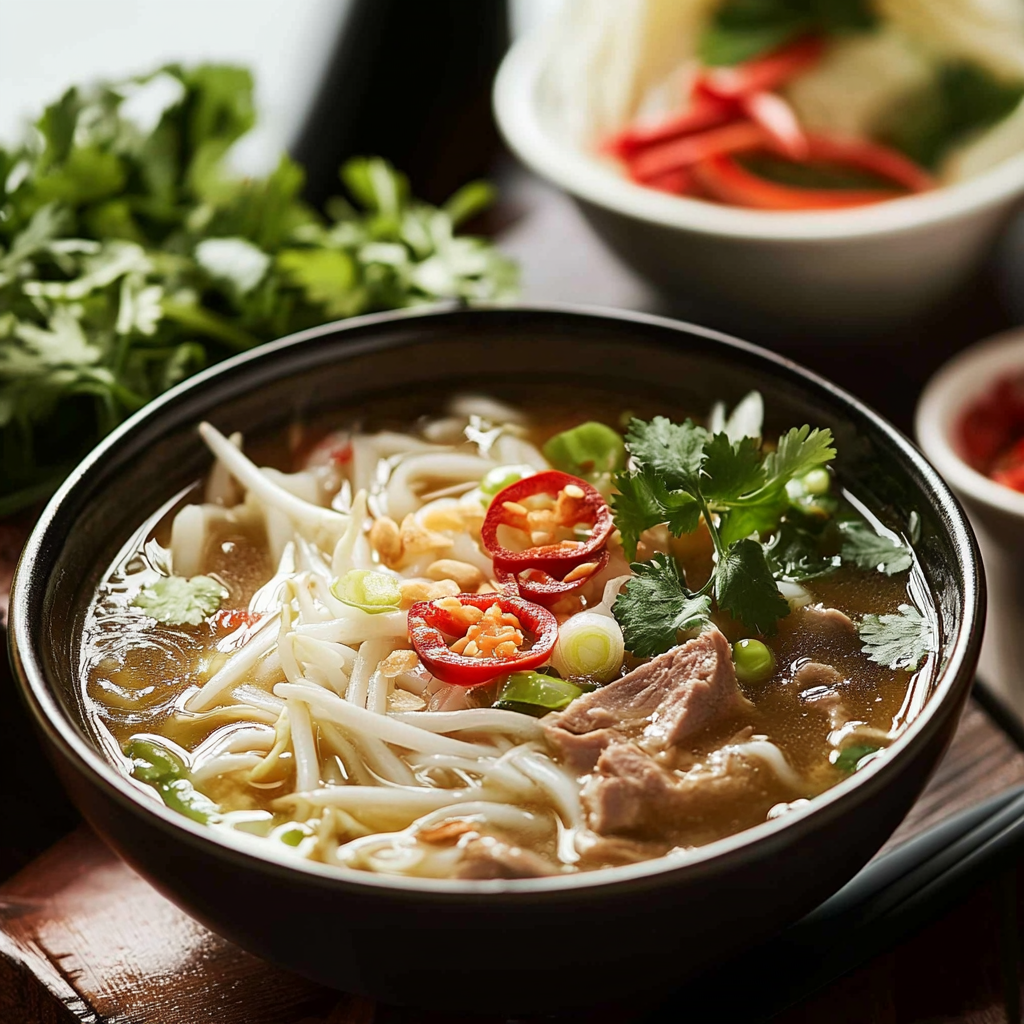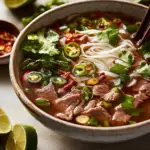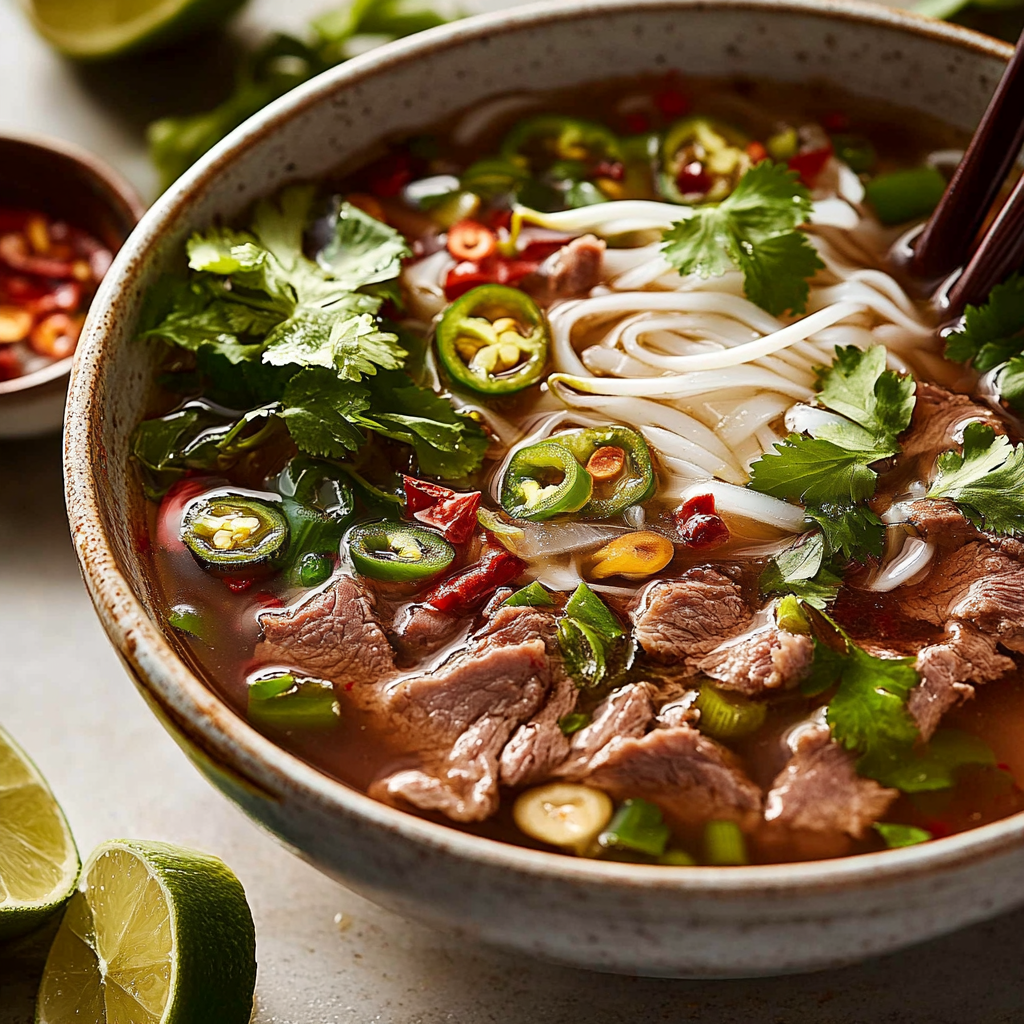Introduction
Have you ever experienced a dish that warms both your body and soul? Imagine a steaming bowl of Vietnamese pho filled with aromatic broth, tender noodles, and an array of vibrant herbs. The first sip envelops your senses in a deliciously complex medley of flavors that dance on your palate. This iconic dish is not just a meal; it’s an experience that transports you to the bustling streets of Vietnam.
Growing up, I remember my grandmother lovingly preparing pho during family gatherings. The tantalizing aroma wafting through the air would bring everyone together around the table. Now, I am excited to share this beloved recipe with you so that you can recreate those cherished memories in your home. Perfect for cozy nights or gatherings with friends, this authentic Vietnamese pho will leave everyone craving more.
Why You’ll Love This Vietnamese pho
Rich Cultural Heritage: Each bowl of Vietnamese pho tells a story steeped in tradition and culture. Originating from the northern regions of Vietnam in the early 20th century, this dish has evolved into various regional styles. By making it at home, you connect with its rich history while enjoying a taste of authenticity.
Customizable Ingredients: One of the best aspects of making your own pho is its versatility. You can tailor it to suit your preferences by choosing different proteins like beef or chicken and adding fresh vegetables or herbs. This adaptability makes it perfect for any dietary needs or personal tastes.
Health Benefits: Pho is not only delicious but also nutritious. The broth is often made from simmering bones over several hours, extracting collagen and minerals that are beneficial for joint health and digestion. Toss in fresh herbs like cilantro and basil for added vitamins and flavor.
Comforting Experience: There’s something incredibly soothing about a warm bowl of pho on a chilly evening. The combination of savory broth and tender noodles creates a comforting sensation that feels like a warm hug from within. It’s the perfect dish for lifting spirits after a long day.
Ingredients
Here’s what you’ll need to make this delicious dish:
- Beef Bones: Select meaty bones for richness—knuckle bones work well for deep flavor.
- Rice Noodles: Use flat rice noodles (Bánh phở), ensuring they’re fresh or dried according to preference.
- Star Anise: This spice adds an unmistakable warmth and complexity to the broth.
- Cinnamon Stick: A stick or two enhances the aromatic profile with natural sweetness.
- Fresh Herbs: Include cilantro and Thai basil for vibrant flavor and freshness.
For the Garnishes:
- Sliced Chili Peppers: These add heat; choose according to your spice tolerance.
The full ingredients list, including measurements, is provided in the recipe card directly below.
How to Make Vietnamese pho
Follow these simple steps to prepare this delicious dish:
Prepare the Broth: Begin by roasting beef bones in an oven preheated to 400°F (200°C) for about 30 minutes until browned. Transfer them into a large pot filled with water, bring it to a boil then reduce heat to simmer.
Add Aromatics: After simmering for one hour, introduce star anise and cinnamon sticks into the pot along with onion halves charred on an open flame until slightly blackened. Allow this mixture to simmer gently for at least three hours.
Skim Impurities: Regularly skim off any foam or impurities that rise to the surface during cooking to ensure a clear broth. This step enhances both appearance and flavor.
Cook Rice Noodles: While waiting on the broth, prepare rice noodles according to package instructions—typically soaking dried noodles in hot water until softened—then drain well.
Assemble Your Pho Bowl: In each serving bowl place cooked noodles topped with thin slices of raw beef (or chicken) if desired. Ladle hot broth over everything until submerged; let sit briefly so meat cooks through gently.
Add Fresh Herbs & Serve: Finish off with fresh herbs like cilantro and Thai basil along with garnishes such as lime wedges and sliced chili peppers before serving immediately for maximum enjoyment.

Tips and Tricks
Here are some helpful tips to ensure the best results for your dish:
Choose Quality Ingredients: Always opt for high-quality meat and fresh spices when preparing your pho; they significantly enhance overall flavor.
Adjust Broth Flavoring: Feel free to tweak spices such as cloves or cardamom based on personal preference—experimenting can lead you to discover your ideal combination!
Don’t Rush Simmering Time: Patience is key! Allowing time for bone extraction creates rich depth; don’t rush this crucial step if you want authentic taste.
Serve Immediately After Assembly: Pho tastes best when served right after assembly; cold ingredients won’t deliver that delightful warmth intended by this comforting dish.
Keeps Well For Leftovers: Store leftovers separately (broth from noodles) in airtight containers; they’ll last up to three days refrigerated without compromising quality!
Mistakes to avoid
Not using fresh herbs
Fresh herbs are essential in Vietnamese pho, as they add depth and aroma to the dish. Using dried herbs or skipping them entirely can lead to a bland flavor profile. Always incorporate fresh basil, cilantro, and lime for that authentic taste. If you can, visit local markets for the freshest options. Remember to add these herbs just before serving to maintain their vibrant flavors and colors. This small step can elevate your pho significantly, making it more enjoyable for everyone at the table.
Overcooking the noodles
Noodles are a crucial component of Vietnamese pho, yet overcooking them can ruin your dish. It’s important to follow package instructions closely, usually cooking rice noodles for about 4-6 minutes until they are tender but still firm. After draining, rinse them with cold water to stop the cooking process. This prevents them from becoming mushy when combined with hot broth later. Remember that the noodles will continue to soften slightly when mixed with the steaming hot soup, so aim for al dente perfection.
Ignoring the broth’s simmering time
The broth is the heart of Vietnamese pho, and its flavor develops through proper simmering. Skipping this step or rushing it can yield a weak broth lacking depth and richness. Aim to simmer your broth for at least 3-4 hours if using bones; this allows nutrients and flavors to extract fully. If you’re short on time, consider pressure cooking for about 1 hour as an alternative. A well-prepared broth is essential for an authentic pho experience that leaves a lasting impression on your taste buds.
Using low-quality meat
The choice of meat can greatly influence the quality of your Vietnamese pho. Opting for low-quality cuts or processed meats will result in an inferior dish that lacks flavor and texture. For traditional pho, choose high-quality beef cuts such as brisket or sirloin; these provide tenderness when cooked correctly. Additionally, consider using bone marrow or oxtail for added richness in your broth. Invest in good meat sources; it pays off in both taste and overall satisfaction when indulging in this beloved dish.
Mistakes to avoid when seasoning
Not tasting the broth during cooking
One common mistake is neglecting to taste your broth while it’s simmering. Flavor profiles change as ingredients meld together over time; what might seem perfect initially could require adjustments later on. Regularly sample your broth after a few hours of simmering; this will help you identify if more salt, sugar, or spices are needed. Remember that seasoning should enhance flavors without overpowering them; achieving balance is key to an authentic Vietnamese pho experience.
Add spices too early
Another frequent error occurs when spices are added too early in the cooking process. Some spices lose their potency over long periods of simmering, resulting in diminished flavor in your Vietnamese pho. Instead, consider adding whole spices like star anise or cinnamon near the end of cooking—this allows their fragrant oils to infuse without becoming muted by prolonged heat exposure. Aim to add these aromatic elements during the last hour of simmering for maximum flavor impact.
Piling on too many toppings
While garnishing your bowl of Vietnamese pho is important, overloading it with toppings can overwhelm its delicate flavors. Stick to a few classic additions like bean sprouts, lime wedges, and sliced chilies to enhance but not mask the dish’s essence. Each topping should complement rather than compete with the rich broth and tender meat you’ve worked hard to prepare. A simple approach ensures every bite remains balanced and highlights all components harmoniously.
Forgetting about acidity
Acidity plays a vital role in balancing flavors within Vietnamese pho but is often overlooked during preparation. Adding lime juice at serving elevates freshness while cutting through richness from fatty ingredients like beef brisket or bone marrow. Don’t skip this step! Squeeze some lime into your bowl just before enjoying your meal; this small action brightens up every spoonful while enhancing overall flavor complexity—making each bite even more enjoyable.
Serving Suggestions
This Vietnamese pho is versatile and pairs wonderfully with fresh herbs like basil, cilantro, and mint. These herbs add vibrant flavors and aromas that elevate the dish. Consider serving a side of lime wedges to squeeze over the soup; this brings a zesty brightness that balances the rich broth. You can also include bean sprouts for a crunchy texture, enhancing the overall experience. Additionally, serve it alongside chili sauce for those who enjoy a spicy kick, allowing each diner to customize their bowl to perfection.
For a complete meal, consider adding spring rolls.
Spring rolls complement Vietnamese pho beautifully, offering a crispy contrast to the warm noodles and broth. You can make them with shrimp or vegetables for added flavor and texture. These light appetizers are perfect for sharing and help create an authentic Vietnamese dining experience at home. Pairing them with a sweet chili dipping sauce further enhances their appeal.
A refreshing salad works well too.
A crisp cucumber salad or a green papaya salad serves as an excellent accompaniment to your pho. The freshness of these salads contrasts nicely with the warm soup and adds a healthy touch to your meal. A simple dressing of fish sauce, lime juice, and sugar can bring out the natural flavors of the ingredients.
Don’t forget about beverages!
Serve your Vietnamese pho with traditional drinks like iced Vietnamese coffee or fresh coconut water. Iced coffee provides a robust flavor that complements the soup’s richness, while coconut water offers a refreshing contrast with its natural sweetness. Both choices enhance your dining experience by adding layers of flavor.

FAQs
What is the best cut of meat for Vietnamese pho?
Choosing the right cut of meat is essential for authentic Vietnamese pho. Brisket works well due to its tenderness and flavor when simmered in broth. For beef pho, flank steak or sirloin is also popular as they cook quickly and retain juiciness without becoming tough.
Can I make vegetarian Vietnamese pho?
Absolutely! Vegetarian pho is delicious and easy to prepare. Use vegetable broth as a base, along with mushrooms, tofu, and plenty of fresh vegetables like bok choy and carrots for added flavor. Seasoning with soy sauce and spices will enhance the taste perfectly.
How do I store leftovers of Vietnamese pho?
To store leftover Vietnamese pho properly, separate the broth from the noodles and toppings to maintain freshness. Store each component in airtight containers in the refrigerator. Consume within three days for optimal quality; reheat on low heat until warmed through before serving again.
What are common herbs used in Vietnamese pho?
Common herbs that enhance Vietnamese pho include Thai basil, cilantro, mint, and green onions. These fresh herbs add aromatic qualities that elevate the dish’s flavor profile significantly. Always serve them on the side so diners can customize their bowls according to personal preferences.
Conclusion
Vietnamese pho is not just a delightful dish; it’s an experience filled with rich flavors and textures that comfort your soul. To complement this traditional soup, consider serving fresh herbs like basil and cilantro alongside crispy spring rolls or refreshing salads. Don’t forget beverages such as iced coffee or coconut water to round out your meal perfectly. Whether you prefer beef or vegetarian options, customizing your bowl allows you to enjoy every bite uniquely tailored to your taste buds. With proper storage techniques for leftovers ensuring freshness is maintained, you can savor this culinary masterpiece even after mealtime has ended! Enjoy creating your own authentic Vietnamese dining experience at home!

Authentic Vietnamese Pho Recipe
- Total Time: 4 hours 30 minutes
- Yield: Serves 4
Description
Vietnamese pho is a beloved noodle soup that warms the soul with its rich, aromatic broth, tender rice noodles, and fresh herbs. This authentic recipe allows you to recreate a comforting bowl of pho at home, offering a delightful culinary experience perfect for family gatherings or cozy nights in.
Ingredients
- 2 lbs beef bones (knuckle bones preferred)
- 8 oz flat rice noodles (Bánh phở)
- 2 star anise
- 1 cinnamon stick
- 1 onion (halved and charred)
- Fresh herbs (cilantro, Thai basil)
- Sliced chili peppers
- Lime wedges
Instructions
- Preheat the oven to 400°F (200°C) and roast the beef bones for 30 minutes until browned.
- Transfer bones to a large pot with water; bring to a boil then reduce heat to simmer.
- After one hour, add star anise, cinnamon stick, and charred onion. Simmer for at least three hours.
- Skim off impurities from the broth for clarity.
- Soak rice noodles in hot water until softened; drain well.
- In serving bowls, add cooked noodles topped with thin slices of raw beef or chicken, then ladle hot broth over.
- Finish with fresh herbs and garnishes before serving.
- Prep Time: 30 minutes
- Cook Time: 4 hours
- Category: Main
- Method: Simmering
- Cuisine: Vietnamese
Nutrition
- Serving Size: 1 bowl (400g)
- Calories: 450
- Sugar: 3g
- Sodium: 920mg
- Fat: 15g
- Saturated Fat: 6g
- Unsaturated Fat: 8g
- Trans Fat: 0g
- Carbohydrates: 50g
- Fiber: 2g
- Protein: 25g
- Cholesterol: 70mg
Keywords: Choose high-quality ingredients for the best flavor. Adjust spices according to your preference; consider adding cloves or cardamom. Serve immediately after assembly for optimal taste; leftovers can be stored separately in airtight containers.
